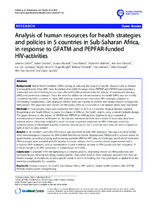| dc.contributor.author | Cailhol, Johann | |
| dc.contributor.author | Craveiro, Isabel | |
| dc.contributor.author | Mathole, Thubelihle | |
| dc.contributor.author | Parsons, Ann Neo | |
| dc.contributor.author | Lehmann, Uta | |
| dc.contributor.author | Sanders, David | |
| dc.contributor.author | Madede, Tavares | |
| dc.contributor.author | Makoa, Elsie | |
| dc.contributor.author | Van Leemput, Luc | |
| dc.contributor.author | Biesma, Regien | |
| dc.contributor.author | Brugha, Ruairi | |
| dc.contributor.author | Chilundo, Baltazar | |
| dc.contributor.author | Dussault, Gilles | |
| dc.contributor.author | Van Damme, Wim | |
| dc.date.accessioned | 2017-06-28T08:48:10Z | |
| dc.date.available | 2017-06-28T08:48:10Z | |
| dc.date.issued | 2013 | |
| dc.identifier.citation | Cailhol, J. et al. (2013). Analysis of human resources for health strategies and policies in 5 countries in Sub-Saharan Africa, in response to GFATM AND Pepfar-funded HIV-activities. Globalization and Health, 9 (52): 1-14 | en_US |
| dc.identifier.issn | 1744-8603 | |
| dc.identifier.uri | http://hdl.handle.net/10566/3004 | |
| dc.description.abstract | BACKGROUND: Global Health Initiatives (GHIs), aiming at reducing the impact of specific diseases such as Human
Immunodeficiency Virus (HIV), have flourished since 2000. Amongst these, PEPFAR and GFATM have provided a
substantial amount of funding to countries affected by HIV, predominantly for delivery of antiretroviral therapy
(ARV) and prevention strategies. Since the need for additional human resources for health (HRH) was not initially
considered by GHIs, countries, to allow ARV scale-up, implemented short-term HRH strategies, adapted to
GHI-funding conditionality. Such strategies differed from one country to another and slowly evolved to long-term
HRH policies. The processes and content of HRH policy shifts in 5 countries in Sub-Saharan Africa were examined.
METHODS: A multi-country study was conducted from 2007 to 2011 in 5 countries (Angola, Burundi, Lesotho,
Mozambique and South Africa), to assess the impact of GHIs on the health system, using a mixed methods design.
This paper focuses on the impact of GFATM and PEPFAR on HRH policies. Qualitative data consisted of
semi-structured interviews undertaken at national and sub-national levels and analysis of secondary data from
national reports. Data were analysed in order to extract countries’ responses to HRH challenges posed by
implementation of HIV-related activities. Common themes across the 5 countries were selected and compared in
light of each country context.
RESULTS: In all countries successful ARV roll-out was observed, despite HRH shortages. This was a result of mostly
short-term emergency response by GHI-funded Non-Governmental Organizations (NGOs) and to a lesser extent by
governments, consisting of using and increasing available HRH for HIV tasks. As challenges and limits of short-term
HRH strategies were revealed and HIV became a chronic disease, the 5 countries slowly implemented mid to
long-term HRH strategies, such as formalisation of pilot initiatives, increase in HRH production and mitigation of
internal migration of HRH, sometimes in collaboration with GHIs.
CONCLUSION: Sustainable HRH strengthening is a complex process, depending mostly on HRH production and
retention factors, these factors being country-specific. GHIs could assist in these strategies, provided that they are
flexible enough to incorporate country-specific needs in terms of funding, that they coordinate at global-level and
minimise conditionality for countries. | en_US |
| dc.language.iso | en | en_US |
| dc.publisher | BioMed Central -The Open Access Publisher | en_US |
| dc.rights | Copyright Authors. This is an open access article under the terms of the Creative Commons Attribution-Non Commercial License. | |
| dc.subject | Human resources for health | en_US |
| dc.subject | Sub-Saharan Africa | en_US |
| dc.subject | HRH policies | en_US |
| dc.subject | Global health initiatives | en_US |
| dc.subject | HIV | en_US |
| dc.subject | GFATM | en_US |
| dc.subject | PEPFAR | en_US |
| dc.subject | Health system strengthening | en_US |
| dc.title | Analysis of human resources for health strategies and policies in 5 countries in Sub-Saharan Africa, in response to GFATM AND Pepfar-funded HIV-activities | en_US |
| dc.type | Article | en_US |
| dc.description.accreditation | Department of HE and Training approved list | |

